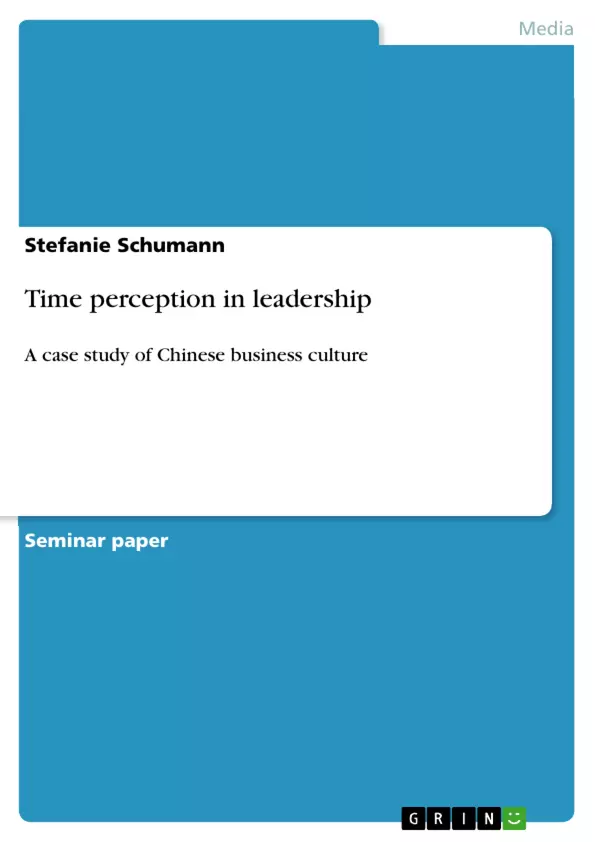Day by day we are woken up by the alarm. The clock schedules our daily routine. Punctuality at work is emphasized. Deadlines are considered to be accomplished on time. The clock drives us to undertake a certain amount of tasks during the day. In Western societies time is considered as resource, which can be spent, saved or lost. Thus, it represents a force, which drives our lives. Timetables and calendars create the feeling of time pressure. This phenomenon implies a big gap between the time an individual lives and the one the same person feels inside like a body clock. Hence, especially in task-oriented management, issues concerning time occur. Furthermore, cultural differences cause a variation of time perceptions. In fact, social time, as a culturally determined interpretation of time, has a great impact on business culture. On the one hand, the sense of social time influences expatriate managers going overseas, who have to adapt the local time perception; on the other hand, it concerns leaders, who have to juggle with two time perceptions in order to organize cross-border collaborations. Punctuality serves as prime example for time perception. While in Western Europe timekeeping represents a virtue, in Southern Europe dates are treated rather flexible.
The time perception of cultural groups varies even more. Monochronicity and polychronicity embody the main perspectives of time. Therefore, their origin and impact will be explained in general as well as in terms of managerial behaviour. After classifying the cultural clusters established by the GLOBE study, the example of the Confucian Asia will be contrasted with Western Europe. Further on, the case study of China serves as prime example of Confucian Asia to underline the influence of the local time perception on the present leadership style. Finally, a behavioural guideline for leaders concerning time perception shall create a harmonious overall picture of this work. Since this paper does not have the extent to scrutinize the influence of all cultural dimensions on leadership style, I chose the issue of time perception, because so far this aspect has been rather neglected in research. The following investigations are supposed to give a guideline to time awareness in general. By analysing the case of China, difficulties and potentials of varying time perceptions regarding managerial success shall be examined.
Table of Contents
- Introduction
- Typology of cultures
- Hall
- Hofstede
- Trompenaars
- Time perception
- Functional vs. social time
- Time orientation: past, present and future
- Monochronic vs. polychronic time perception
- Time perception and leadership
- Types of leadership
- Culture & leadership
- Expatriate managers in between time perceptions
- The impact of time perception on decision-making
- Monochronicity and polychronicity in global business
- China a case study of time perception in business
- The Chinese flow of time: Confucianism and Taoism
- Leadership style
- Confucian leadership style
- Characteristics of Chinese leadership
- Doing business with China – do's and dont's concerning Chinese time perception
- Conclusion
Objectives and Key Themes
This paper aims to examine the influence of time perception on leadership style, particularly in the context of Chinese business culture. It explores the concept of time perception within different cultural frameworks and its impact on management practices, decision-making, and cross-border collaborations.
- The role of time perception in various cultures.
- The relationship between cultural differences and leadership styles.
- The challenges and opportunities of managing time in global business environments.
- The specific case study of Chinese business culture and its unique time perception.
- Practical guidelines for leaders navigating time perception differences in cross-cultural collaborations.
Chapter Summaries
The paper begins by introducing the concept of time perception as a key cultural dimension, highlighting its influence on individual experiences and managerial practices. It then presents a typology of cultures based on different frameworks like Hall's model, Hofstede's dimensions, and Trompenaars' perspectives. Chapter 2.4 delves into the nuances of time perception, exploring concepts like functional vs. social time, time orientation, and monochronic vs. polychronic perspectives. The paper then explores the relationship between time perception and leadership, examining how cultural differences impact leadership styles, expatriate management, and decision-making processes. The case study of China serves as a prime example of Confucian Asia, examining how the local time perception influences leadership style and business practices. The chapter also provides practical guidelines for leaders to navigate time perception differences when collaborating with Chinese counterparts.
Keywords
This work focuses on the concept of time perception and its impact on leadership within a global business context. Key terms include intercultural communication, cultural dimensions, monochronicity, polychronicity, time orientation, leadership styles, cultural sensitivity, cross-cultural management, Chinese business culture, Confucianism, Taoism, and practical guidelines for managing time perception differences.
- Quote paper
- Stefanie Schumann (Author), 2011, Time perception in leadership, Munich, GRIN Verlag, https://www.grin.com/document/170587



